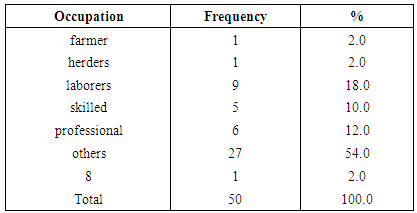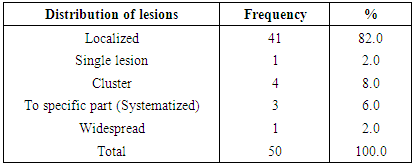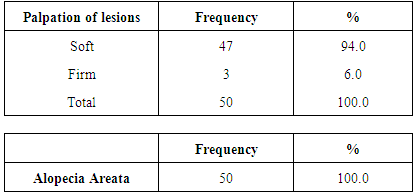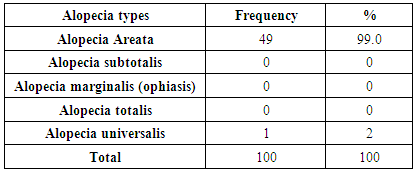| [1] | Tan E, Tay YK, Giam YC. A clinical study of childhood alopecia areata in Singapore. Pediatr Dermatol. 2002 Jul-Aug; 19(4):298-301. |
| [2] | Tazi-Ahnini R, Cork MJ, Gawkrodger DJ, Birch MP, Wengraf D, McDonagh AJ, and Messenger AG. Role of the autoimmune regulator (AIRE) gene in alopecia areata: strong association of a potentially functional AIRE polymorphism with alopecia universalis. Tissue Antigens. 2002 Dec; 60(6): 489-95. |
| [3] | Green J, Sinclair RD. Genetics of alopecia areata. Australas J Dermatol. 2000 Nov; 41(4): 213-8. |
| [4] | Tazi-Ahnini R, di Giovine FS, McDonagh AJ, Messenger AG, Amadou C, Cox A, Duff GW, Cork MJ. Structure and polymorphism of the human gene for the interferon-induced p78 protein (MX1): evidence of association with alopecia areata in the Down syndrome region. Hum Genet. 2000 Jun; 106(6): 639-45.). |
| [5] | Tazi-Ahnini R, McDonagh AJ, Cox A, Messenger AG, Britton JE, Ward SJ, Bavik CO, Duff GW, Cork MJ. Association analysis of IL1A and IL1B variants in alopecia areata. Heredity. 2001 Aug; 87(Pt 2):215-9. |
| [6] | Yosefy C, Ronnen M, Edelstein D. Pseudo alopecia areata caused by skull-caps with metal pin fasteners used by Orthodox Jews in Israel. Clin Dev Immunol. 2003 Jun-Dec; 10(2-4):193-5. |
| [7] | McDonagh AJ, Messenger AG: The pathogenesis of alopecia areata. Dermatol Clin 1996 Oct; 14(4): 661-70. |
| [8] | Perini GI, Veller Fornasa C, Cipriani R, et al.: Life events and alopecia areata. Psychother Psychosom 1984; 41(1): 48-52. |
| [9] | Kalish RS, Johnson KL, Hordinsky MK. Alopecia areata. Autoreactive T cells are variably enriched in scalp lesions relative to peripheral blood. Arch Dermatol. 1992 Aug; 128(8): 1072-7. |
| [10] | Tazi-Ahnini R, Cork MJ, Gawkrodger DJ, Birch MP, Wengraf D, McDonagh AJ, and Messenger AG. Role of the autoimmune regulator (AIRE) gene in alopecia areata: strong association of a potentially functional AIRE polymorphism with alopecia universalis. Tissue Antigens. 2002 Dec; 60(6): 489-95. |
| [11] | Rokhsar CK, Shupack JL, Vafai JJ, Washenik K: Efficacy of topical sensitizers in the treatment of alopecia areata. J Am Acad Dermatol 1998 Nov; 39(5 Pt 1): 751-61). |
| [12] | Mainardi E, Montanelli A, Dotti M, Nano R, Moscato G. Thyroid-related autoantibodies and celiac disease: a role for a gluten-free diet?J Clin Gastroenterol. 2002 Sep; 35(3):245-8. |
| [13] | Galbraith GM, Thiers BH, Pandey JP. Gm allotype associated resistance and susceptibility to alopecia areata. Clin Exp Immunol. 1984 Apr; 56(1):149-52. |
| [14] | Price VH, Colombe BW: Heritable factors distinguish two types of alopecia areata. Dermatol Clin 1996 Oct; 14(4): 679-89. |
| [15] | Colombe BW, Price VH, Khoury EL, Garovoy MR, Lou CD. HLA class II antigen associations help to define two types of alopecia areata. J Am Acad Dermatol. 1995 Nov; 33(5 Pt 1): 757-64. |
| [16] | Kavak A, Baykal C, Ozarmagan G, Akar U. HLA in alopecia areata. Int J Dermatol. 2000 Aug; 39(8):589-92. |
| [17] | Tazi-Ahnini R, McDonagh AJ, Cox A, Messenger AG, Britton JE, Ward SJ, Bavik CO, Duff GW, Cork MJ. Association analysis of IL1A and IL1B variants in alopecia areata. Heredity. 2001 Aug; 87(Pt 2):215-9. |
| [18] | Yang S, Yang J, Liu JB, Wang HY, Yang Q, Gao M, Liang YH, Lin GS, Lin D, Hu XL, Fan L, Zhang XJ. The genetic epidemiology of alopecia areata in China. Br J Dermatol. 2004 Jul; 151(1):16-23. |
| [19] | Tazi-Ahnini R, di Giovine FS, McDonagh AJ, Messenger AG, Amadou C, Cox A, Duff GW, Cork MJ. Structure and polymorphism of the human gene for the interferon-induced p78 protein (MX1): evidence of association with alopecia areata in the Down syndrome region. Hum Genet. 2000 Jun; 106(6):639-45. |
| [20] | van der Steen P, Traupe H, Happle R, Boezeman J, Strater R, Hamm H. The genetic risk for alopecia areata in first-degree relatives of severely affected patients. An estimate. Acta Derm Venereol. 1992 Sep; 72(5):373-5. |
| [21] | Shellow WV, Edwards JE, Koo JY. Profile of alopecia areata: a questionnaire analysis of patient and family. Int J Dermatol. 1992 Mar; 31(3):186-9. |
| [22] | McElwee KJ, Tobin DJ, Bystryn JC, et al.: Alopecia areata: an autoimmune disease? Exp Dermatol 1999 Oct; 8(5): 371-9). |
| [23] | Colombe BW, Price VH, Khoury EL, et al.: HLA class II antigen associations help to define two types of alopecia areata. J Am Acad Dermatol 1995 Nov; 33(5 Pt 1): 757-64. |
| [24] | Ruiz-Doblado S, Carrizosa A, Garcia-Hernandez MJ. Alopecia areata: psychiatric comorbidity and adjustment to illness. Int J Dermatol. 2003 Jun; 42(6):434-7. |
| [25] | Muller, SA: Alopecia areata: an evaluation of 736 patients. Arch Dermatol 1963; 88: 106-13. |
| [26] | Nanda A, Al-Fouzan AS, Al-Hasawi F. Alopecia areata in children: a clinical profile. Pediatr Dermatol. 2002 Nov-Dec; 19(6):482-5. |
| [27] | Tan E, Tay YK, Giam YC. A clinical study of childhood alopecia areata in Singapore. Pediatr Dermatol. 2002 Jul-Aug; 19(4):298-301. |
| [28] | Sharma VK, Dawn G, Kumar B. Profile of alopecia areata in Northern India. Int J Dermatol. 1996 Jan; 35(1):22-7. |
| [29] | Ro BI. Alopecia areata in Korea (1982-1994).J Dermatol. 1995 Nov; 22(11):858-64. |
| [30] | Shellow WV, Edwards JE, Koo JY. Profile of alopecia areata: a questionnaire analysis of patient and family. Int J Dermatol. 1992 Mar; 31(3):186-9. |
| [31] | Safavi KH, Muller SA, Suman VJ, Moshell AN, Melton LJ 3rd. Incidence of alopecia areata in Olmsted County, Minnesota, 1975 through 1989. Mayo Clin Proc. 1995 Jul; 70(7):628-33. |
| [32] | Tan E, Tay YK, Goh CL, Chin Giam Y. The pattern and profile of alopecia areata in Singapore--a study of 219 Asians. Int J Dermatol. 2002 Nov; 41(11):748-53. |
| [33] | Nanda A, Al-Fouzan AS, Al-Hasawi F. Alopecia areata in children: a clinical profile. Pediatr Dermatol. 2002 Nov-Dec; 19(6):482-5. |
| [34] | Sharma VK, Dawn G, Kumar B. Profile of alopecia areata in Northern India.Int J Dermatol. 1996 Jan; 35(1): 22-7. |
| [35] | Ro BI. Alopecia areata in Korea (1982-1994). J Dermatol. 1995 Nov; 22(11):858-64. |
| [36] | Shellow WV, Edwards JE, Koo JY. Profile of alopecia areata: a questionnaire analysis of patient and family. Int J Dermatol. 1992 Mar; 31(3):186-9. |
| [37] | Bertolino AP. Alopecia areata. A clinical overview. Postgrad Med. 2000 Jun; 107(7):81-5, 89-90. |
| [38] | Taylor CR, Hawk JL: PUVA treatment of alopecia areata partialis, totalis, and universalis: audit of 10 years' experience at St John's Institute of Dermatology. Br J Dermatol 1995 Dec; 133(6): 914-8. |
| [39] | Ro BI. Alopecia areata in Korea (1982-1994). J Dermatol. 1995 Nov; 22(11):858-64. |
| [40] | Ro BI. Alopecia areata in Korea (1982-1994). J Dermatol. 1995 Nov; 22(11):858-64. |
| [41] | Ro BI. Alopecia areata in Korea (1982-1994). J Dermatol. 1995 Nov; 22(11):858-64. |
| [42] | Shellow WV, Edwards JE, Koo JY. Profile of alopecia areata: a questionnaire analysis of patient and family. Int J Dermatol. 1992 Mar; 31(3):186-9. |
| [43] | Hoffmann R, Happle R: Topical immunotherapy in alopecia areata. What, how, and why? Dermatol Clin 1996 Oct; 14(4): 739-44. |
| [44] | Ro BI. Alopecia areata in Korea (1982-1994). J Dermatol. 1995 Nov; 22(11):858-64. |
| [45] | Ro BI. Alopecia areata in Korea (1982-1994). J Dermatol. 1995 Nov; 22(11):858-64. |
| [46] | Dominguez Ortega L. Narcolepsy and alopecia areata: a new association? An Med Interna. 1992 May; 9(5):234-6. |
| [47] | Shellow WV, Edwards JE, Koo JY. Profile of alopecia areata: a questionnaire analysis of patient and family. Int J Dermatol. 1992 Mar; 31(3):186-9. |
| [48] | Werth VP, White WL, Sanchez MR, Franks AG. Incidence of alopecia areata in lupus erythematosus. Arch Dermatol. 1992 Mar; 128(3):368-71. |
| [49] | Isa AR, Noor M. Non-ionizing radiation exposure causing ill-health and alopecia areata. Med J Malaysia. 1991 Sep; 46(3):235-8. |
| [50] | No authors listed. Epidemiological evidence of the association between lichen planus and two immune-related diseases. Alopecia areata and ulcerative colitis. Gruppo Italiano Studi Epidemiologici in Dermatologia. Arch Dermatol. 1991 May; 127(5):688-91. |
| [51] | Somos Z, Horvath T. Alopecia areata and bis albuminaemia (a casual coincidence). Acta Med Hung. 1989; 46(2-3):163-7. |
| [52] | Hatzis J, Kostakis P, Tosca A, Parissis N, Nicolis G, Varelzidis A, Stratigos J. Nuchal nevus flammeus as a skin marker of prognosis in alopecia areata. Dermatologica. 1988; 177(3): 149-51. |
| [53] | Puavilai S, Puavilai G, Charuwichitratana S, Sakuntabhai A, Sriprachya-Anunt S. Prevalence of thyroid diseases in patients with alopecia areata. Int J Dermatol. 1994 Sep; 33(9):632-3. |
| [54] | Puavilai S, Puavilai G, Charuwichitratana S, et al.: Prevalence of thyroid diseases in patients with alopecia areata. Int J Dermatol 1994 Sep; 33(9): 632-3. |
| [55] | Broniarczyk-Dyla G, Lewinski A, Zerek-Melen G, Sewerynek E, Wozniacki A. Abnormalities of structure and function of the thyroid in patients with alopecia areata. Przegl Dermatol. 1989 Sep-Dec; 76(5-6):416-21. |
| [56] | Tosti A, De Padova MP, Minghetti G, Veronesi S: Therapies versus placebo in the treatment of patchy alopecia areata. J Am Acad Dermatol 1986 Aug; 15(2 Pt 1): 209-10. |
| [57] | Taylor CR, Hawk JL: PUVA treatment of alopecia areata partialis, totalis and universalis: audit of 10 years' experience at St John's Institute of Dermatology. Br J Dermatol 1995 Dec; 133(6): 914-8. |
| [58] | Wang SJ, Shohat T, Vadheim C, Shellow W, Edwards J, Rotter JI. Increased risk for type I (insulin-dependent) diabetes in relatives of patients with alopecia areata (AA). Am J Med Genet. 1994 Jul 1; 51(3):234-9. |
| [59] | Tazi-Ahnini R, di Giovine FS, McDonagh AJ, Messenger AG, Amadou C, Cox A, Duff GW, Cork MJ. Structure and polymorphism of the human gene for the interferon-induced p78 protein (MX1): evidence of association with alopecia areata in the Down syndrome region. Hum Genet. 2000 Jun; 106(6):639-45. |
| [60] | Koo JY, Shellow WV, Hallman CP, Edwards JE. Alopecia areata and increased prevalence of psychiatric disorders. Int J Dermatol. 1994 Dec; 33(12):849-50. |
| [61] | Wygledowska-Kania M, Bogdanowski T. Testing the significance of psychic factors in the etiology of alopecia areata. II. Examination of personality by means of Eysenck's Personality Inventory (MPI) adapted by Choynowski. Przegl Lek. 1995; 52(11): 562-4. |
| [62] | Liakopoulou M, Alifieraki T, Katideniou A, Kakourou T, Tselalidou E, Tsiantis J, Stratigos J. Children with alopecia areata: psychiatric symptomatology and life events. J Am Acad Child Adolesc Psychiatry. 1997 May; 36(5):678-84. |
| [63] | Jackow C, Puffer N, Hordinsky M, et al.: Alopecia areata and cytomegalovirus infection in twins: genes versus environment? J Am Acad Dermatol 1998 Mar; 38(3): 418-25. |
| [64] | Suzuki S, Shimoda M, Kawamura M, Sato H, Nogawa S, Tanaka K, Suzuki N, Kuwana M. Myasthenia gravis accompanied by alopecia areata: clinical and immunogenetic aspects. Eur J Neurol. 2005 Jul; 12(7): 566-70. |
| [65] | Corazza GR, Andreani ML, Venturo N, Bernardi M, Tosti A, Gasbarrini G. Celiac disease and alopecia areata: report of a new association. Gastroenterology. 1995 Oct; 109(4):1333-7. |
| [66] | Kubota A, Komiyama A, Hasegawa O. Myasthenia gravis, and alopecia areata. Neurology. 1997 Mar; 48(3):774-5. |
| [67] | Roselino AM, Almeida AM, Hippolito MA, Cerqueira BC, Maffei CM, Menezes JB, Vieira RE, Assis SL, Ali SA. Clinical-epidemiologic study of alopecia areata. Int J Dermatol. 1996 Mar; 35(3):181-4. |
| [68] | Tosti A, Morelli R, Bardazzi F, Peluso AM. Prevalence of nail abnormalities in children with alopecia areata. Pediatr Dermatol. 1994 Jun; 11(2):112-5. |
| [69] | Garcia-Hernandez MJ, Rodriguez-Pichardo A, Camacho F. Congenital triangular alopecia (Brauer nevus). Pediatr Dermatol. 1995 Dec; 12(4):301-3. |
| [70] | Trakimas C, Sperling LC, Skelton HG 3rd, Smith KJ, Buker JL. Clinical and histologic findings in temporal triangular alopecia. J Am Acad Dermatol. 1994 Aug; 31(2 Pt 1):205-9. |
| [71] | van der Steen P, Traupe H, Happle R, et al.: The genetic risk for alopecia areata in first-degree relatives of severely affected patients. An estimate. Acta Derm Venereol 1992 Sep; 72(5): 373-5. |
| [72] | Bystryn JC, Orentreich N, Stengel F. Direct immunofluorescence studies in alopecia areata and male pattern alopecia. J Invest Dermatol. 1979 Nov; 73(5):317-20. |
| [73] | MacDonald N: Alopecia areata: identification and current treatment approaches. Dermatol Nurs 1999 Oct; 11(5): 356-9, 363-6. |
| [74] | Safavi KH, Muller SA, Suman VJ, Moshell AN, Melton LJ 3rd. Incidence of alopecia areata in Olmsted County, Minnesota, 1975 through 1989. Mayo Clin Proc. 1995 Jul; 70(7): 628-33. |



 Abstract
Abstract Reference
Reference Full-Text PDF
Full-Text PDF Full-text HTML
Full-text HTML
















